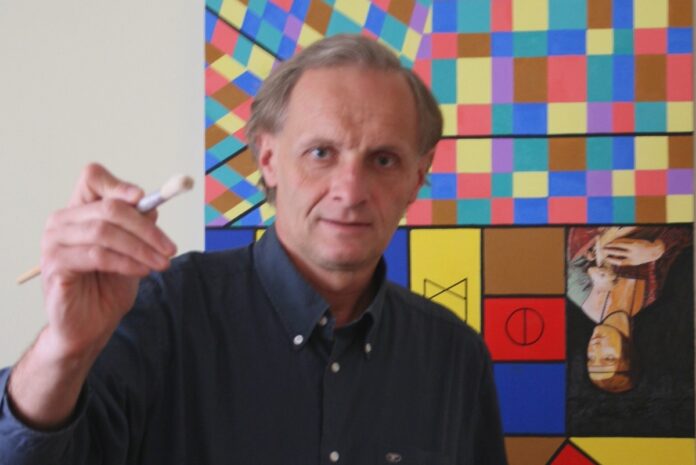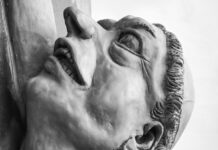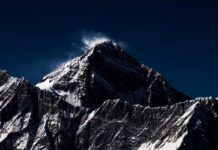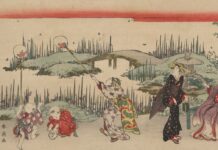City of Sleepwalkers – A Novel By Constantin Severin
(An excerpt)
The death of words – the most apt motto for the chapter of the post-human era.
V.
I don’t know what happened to Olav Thorsen, but after the first meeting he disappeared completely from my life, now I will have to tell my story only to the readers of this book. I had all sorts of thoughts, at first I thought he was angry with me for stating at the end of our dialogue that I could never fall in love with him. Later, after three months, the experiment in Patagonia ended and we were “parachuted” home with $3,000 in our pockets, each to the place from which we had been kidnapped, and I tried to search for Olav on the Internet and was simply horrified when I realized that his name had completely disappeared from the virtual world, his articles in the Psychological Review were deleted, there was no reference in Google Scholar. A veritable ritualistic killing in the online galaxy. I stagger around the house and am overwhelmed by dark thoughts, I open the window but no longer perceive any of the daily bustle outside, my gaze has fallen in. I don’t want to look anymore, people’s sharp gazes dissect my heart in two, I’ve been given to love only beings with the fragile gazes of fairies, shaggy little deer or angels, I prefer to browse the tabs of a dutiful gaze where letters of ether entwine with mystery in the encyclopedia of the gaze, from time to time I tear the tabs where hateful, cunning and lustful gazes have been printed, I like to fall asleep with my head on the encyclopedia of gaze and dream that my heart of rays is the gaze of God, I don’t want to look anymore, the sharp gazes of men dissect my heart in two.
All my life I’ve been thinking about a phrase from the ancient Buddhist teachings: You cannot truly cross a path until you have become the path itself. Unfortunately my path has turned out to be a double helix of the human condition, half the path of joy and the other half the path of suffering, a thick tail of contradictory experiences that I always carry around my heart and with which I must identify in order to move forward, otherwise I become a blinding text that can blind you, the readers of this book. A blind being bringing blindness to the world around is a myth of mine that has often troubled my reveries and actions, a blind bird bringing blindness to the angels in the sky, a blind lion spreading blindness among the other animals of the jungle, a blind mole carrying the fire of blindness into the underworld. It has always haunted me, like an unseeable shadow, the dream of reading or writing a book that blinds me, a book with diamond letters in which pulsates all that I will and will not ever see. It’s a vision I’ve had since childhood after numerous encounters with Mandal, the blind beggar in Patan’s central square (Lalitpur is his historical name, the place where I saw the light of day), the deaf-bearded man originally from Mongolia, whom my best friend Samita and I nicknamed the Saint of Mice. Every morning, after he took his place on a mat placed on the ground a few feet from the Buddha statue, almost all the mice from the nearby buildings would arrive squeaking with joy, surround him in concentric circles and seem to curtsy as they tried to stand up on two legs, their lively little eyes glowing with a supernatural light, some climbed on his clothes and let themselves loose in his large pockets in a mad play, their shapes through the white fabric looked like tiny propellers in full flight, and Mandal muttered strange words and threw them small pieces of sel roti (rice-flour bagels and doughnuts) or rice grains, which he bought with money offered by passers-by. It was the only place where I could take a mouse in my hand and pet it, next to the gentle beggars their fear of people disappeared as if by magic, there they felt happy and safe.
-Do you know how to speak the language of mice?
-Yes, I learned it word for word during my dreams in my teens, when I sleepwalked for several years. I lived with my parents in a poor, outlying neighbourhood in the small town of Baruun-Urt in eastern Mongolia, a chaotic cluster of huts and yurts, a veritable mouse paradise. A language that blinded me as I learned it, ultrasound or simply my burning desire to see something else melted my retina, I was aware of what was happening to me but I decided to move on, fascinated by the new world I was beginning to perceive with my mind’s eye. I was seeing perfect and ingeniously merged shapes from the farthest galaxies, pulsars, Siamese stars and black holes in indescribable colours that kept me breathless, a daily drug that I can’t get rid of even now.
-Yet, don’t you regret giving up the small joys of an ordinary life for a virtual adventure? Wouldn’t it have been better to love a woman, have children and grandchildren? My father once told me that he feels immortal because he has children.
-You know that now, in my old age, I agree with you, but nothing can be done, everything is irreversible and I will continue to live in the invisible world, devoid of the flavour of human joys and mistakes. But you should know that your generation and especially future generations will also live in virtual reality, a reality with a completely different metaphysics from the one described by Aristotle.
The life of a Nepalese family is torn between the traditional and the modern world, by the tensions between the many gods (Buddhist, Hindu, etc.) and the demons that are hard to reconcile in the lives of heretics and atheists (far fewer than in the West), by the paradoxical symbiosis between spirit and matter. My first memory, at the age of three: my mother lying on the bed with an enormous belly, around her two women in white coats, one holding her legs and the other pulling hard, they signal me to go out, after a few minutes I hear from the porch the shrill scream of my brother Tej, my father hugs me and asks me to wait quietly outside, and he enters the room. But I also remember perfectly the state of restlessness and constant agitation I had shortly before this memorable event of our family, I had a doll in my arms and kept talking to it, I was spinning around until I collapsed on the shiny planks and could no longer hear the rustling of the leaves and the chirping of the birds in the garden, I was falling into myself. The harmony of life: thinking before thinking, feeling before feeling, loving before loving, writing before writing, being one step ahead of the event. Everything I have achieved has been accompanied by a premonitory breeze. I have lived more intensely in the crucible of an event, in the magical interval between the done and the undone, between the born and the unborn, in a brittle and human inner territory, forgotten by the gods. I grew up with the medieval city of the Newa era in my soul, an almost surreal composition of lace and filigree stories carved in stone, red brick, metal and fine fabrics, an incredible urban embodiment of Hindu and Buddhist religious ideas that communicate intimately with each other and are enhanced in the dozens of monasteries and temples, but also in the hundreds of stupas, mound-like Buddhist buildings, conical, pyramidal or bell-shaped – a symbolic representation of Buddha’s mind – containing relics (funerary urns, hairs, teeth of Buddha or holy monks), cylindrical copper or silver prayer shawls, narrow alleyways in which two or three-storey brick buildings are packed with families of all generations. There are no Western-style cemeteries with fancy vaults here, our dead often rest close to home, many streets are lined with rows of small stupas in which residents deposit urns with the ashes of their loved ones, the modest cone-trunk relics accompanied by prayer mantras with the sacred inscription Om mani padme hum (‘O diamond that shines in the sun’). I believe that where you are born and spend your childhood greatly influences your thoughts, feelings and character. I have set my sights high since my childhood, probably marked by the fact that I was born in the country with the highest mountains in the world, but especially by the words of my mother, Kaya, who instilled in my mind another Buddhist truth: “In life you don’t necessarily have to conquer Everest. He who conquers himself is stronger than he who conquers a thousand times a thousand men on the battlefield. Be victorious over yourself and not others.” I was fortunate enough to be endowed with good genes to dare to tread the long road of conquering the inner Everest, my mother is the granddaughter of Nepal’s most important contemporary mathematician, Naya Raj Pant (1913-2002), also a noted poet and historian, and my father, Kumal Rajvanshi, comes from a family of well-known engineers and university professors in Mumbai, India. They met in 1984 in Mumbai, where my mother was playing sarangi in a traditional Nepali music group formed by the college in Patan where she was studying. It was an international festival, with local music and dance groups from several Central and South Asian countries taking part. My father was one of the spectators who came on stage and gave her flowers, he was a final year student at the Institute of Technology, one of the most prestigious in Asia, and an avid mountaineer, he had already been to Nepal several times and had conquered three peaks, Chamar, Numbur and Ama Dablam. He then waited for her at the end of the show and managed to get the phone number of the girl he had fallen in love with at first sight, and a year later he arrived in Patan and asked her to marry him. Together with Sunar, his mother’s brother, the newly-minted IT engineer from Mumbai managed to open a repair shop for phones, radios and TVs in an old building on Krishna Galli Road near the Zenith Hotel. During my teenage years this workshop, which I used to visit very often, was full of desktop computers, laptops and mobile phones and I was passionate about mathematics, software and robotics and was starting to have hacking skills, so good was I. Besides, in this workshop I had the opportunity to meet some hackers from Patan, one of them was part of a powerful group in India, which damaged many public and private institutions in the US, UK and China. Kaya and Kumal have different looks and personalities, but they get along well, my mother is a kindergarten teacher and she is small and frail, with big black almond-shaped eyes, almost white skin, pale yellow, very communicative, cheerful and full of energy, my father is tall and strong, with a thoughtful face and curly black hair, olive complexion, very reserved and stingy when talking, but with a childlike soul. “Men and women sleep on the same pillow, but they have different dreams”, a Mongolian proverb I learned from Mandal now comes to mind. Luckily my parents had more shared dreams where my younger brother Tej and I were pampered, loved and privileged. I was 15 when my mother’s uncle in Kathmandu, Naya Raj Pant, died, I attended the funeral ceremony with my parents, and after the funeral urn was deposited in one of the city’s most beautiful pyramid-shaped stupas, we were invited to his home, where among other things I photographed with my smartphone the last page of his diary, left open on the massive walnut desk: “It is not true that I seek mental pleasure, or that my mind is dazzled by worldly things, that I try to gain friends, land or wealth, or yearn for my own elevation. I walk steadfastly on my way, ignoring excessive insults every day, because I am convinced that all the knowledge accumulated by my ancestors is capable of doing good to people.”
These touching phrases, which I treasure, have also helped me to move forward at the turning points of my life, and I have sought more the soul’s pleasure, that which springs from the heart, than mental pleasure, although I have had many satisfactions in my career in which my mind has been in the foreground.
The world of words is enigmatic and endless, Mandal is convinced that there are words that turn into ultrasound when you say them. Learning new words-that is the essence of life and of this book. From time to time, extremely rarely, some new words turn into new affections, something only great writers and inventors do-that’s why they write. I like word-dolls, to hold, love and sleep with my head on their cushion of air and diamonds. Not far from our house is a workshop where I used to go sometimes to admire two craftsmen who made doll-sized statues of Buddha using pieces of bronze, an autogenous welder, pliers and hammers. I must have been 10 years old when I asked my mother to bring me some coloured cloths from a friend who worked in a textile factory, and that’s how I managed to sew my first Buddha-doll with great passion and patience. Others followed, which I gave as gifts to friends, then the idea came to me to give life of cloth, thread and love to characters from fairy tales I read in the evenings, followed by actors I loved. At that time many American films were playing in Patan cinemas, and I was fascinated by the play and the silent distinction of Humphrey Bogart, the only character I ever embodied in a larger size, almost as big as my height, a piece I worked on for three months. I began to sleep at night with Humphrey Bogarth in my bed, caressing and kissing him, falling in love with my own creation, being a Pygmalion in a skirt, replaying in my mind’s eye the scenes with him, hearing his deep, melodic voice, glancing at the calculated, charming gestures, the elegance with which he lit a cigarette or took off his iconic hat. A few years later I was holding in my arms a living doll whom I love more than a sister, Samita Bajracharya, a tall, slender girl with a smile that seems to spring from her whole face, from every muscle of her face and from the light pouring like golden threads from her large, deep-black pupils, from her dark purple irises, from the eyebrows arched like musical notes, from the beautiful, gentle nose, the fleshy, soft lips of Tibetan velvet, the slightly tilted, ever-blushing ears with golden earrings, the forehead with lights and shadows and inscrutable lines that fade into infinity, a delicate creature with a sweet voice vibrating with harmonious sounds. Our mothers have been friends for over 50 years, since kindergarten, all the more reason to always welcome me into her family, who live in a chic house on Gabahal Street. Samita’s childhood somehow magically flowed under the aura of the Hindu goddess Durga, who fights against evil forces and ensures the protection, strength and flourishing of motherhood, and at the age of eight the Buddhist and Hindu communities of Patan and all over South Asia would come with offerings to worship her at the temple and receive blessings from the beautiful little girl with the shy doe eyes, dressed in festive red (the colour of creative energy) and wearing red, yellow and black make-up, and considered by all to be the reincarnation of the popular invincible goddess, thus becoming a living goddess herself, kumari. There were several candidates for this sacred title, only girls from the ancient Newari dynasty, the founder of Medieval culture in the Kathmandu Valley at the foot of the Himalayas, representing the Hakha Bahal Buddhist community, more precisely from the two castes Shakya and Bajracharya, and the selection process was extremely rigorous and lengthy, from the perfect knowledge of religious rituals to the identification of the 32 signs of perfection by the most famous priests of the land (the chosen one must have the thighs of a deer, the heart of a lion, a golden complexion, a neck like a shell, a body like a fig tree, a sweet voice like a duck, etc.). A legend from the world of Dracula circulates in Nepal, where in the past there was a terrifying ordeal, an amphitheatre of horrors in which animals (108 goats and buffalo) were slaughtered while masked men frantically performed ritual dances over the blood spilled on the floor, then at night the candidates were left to sleep next to the dead animals, and those who were frightened and cried were excluded. After she was elected kumari, we were advised not to call her Samita but Dya Mayju (Little Goddess), and she was no longer allowed to touch the ground with her sacred feet, she was carried to temples or monasteries by her father, she did not go to school, a deity is omniscient, she had to consume only certain foods, for example eggs were forbidden. In her room at home a prayer place (puja) was set up and every morning her family members, mother, father and brother performed prayer rituals (nitya puja) before her, and when I visited my friend I was not allowed to touch her, only to talk and possibly play while keeping our distance. Her mother told me that she felt both happy and unhappy, happy and proud to have a goddess in the house, but unhappy because she feared they would not be able to follow all the rules, a veritable oral encyclopaedia of rituals, attitudes, gestures, clothes and appropriate words. Apart from me, only one other good friend of hers, Chanira Bajracharya, who had been invested as a kumari before her and who helped a lot with advices to ensure success in her many duties as a goddess in life, was welcome in the house. Most evenings the three of us would have dinner together, each of us having a portion of dal bhat (rice, lentil soup, chicken and vegetables) or momos (meatballs made of vegetables and minced lamb or chicken wrapped in rice flour envelopes and served with sauces and mayonnaise) or samosa (a spicy dish, a mixture of mashed potatoes and seasoning, all wrapped in a triangular envelope of white flour) and for dessert the ever-present sel roti, so sought after by pilgrims at the two major annual religious festivals and at the Holi festival of colours in March, which is much appreciated by young people and children who splash themselves with paints in all the colours of the rainbow on that day. Both Chanira and I then headed home with a bag full of sweets, chocolates and toys, offerings Samita received from believers across the country.
-Little Deer-legged Goddess, why aren’t you allowed to play an instrument?
-I was told that human music is impure, it captures too many passions and weaknesses, and I am not allowed to disturb the music of the spheres. Besides, I always have to be very careful not to hurt myself, any bleeding leads to the loss of kumari status, you know from our tradition that when the first menstrual cycle arrives I will become impure and lose all connection with the divine world, becoming an ordinary girl again.
-What has changed in your mind and soul, do you feel that you are not the same as before?
-I tell you honestly that I still do not realize that I have changed, although I seem to feel that I have more energy, my body is warmer than before and I have begun to anticipate events better, but the reverence with which I am surrounded by the many believers, their belief that I can heal the sick and fulfill their desires make me believe that the goddess Durga is doing her work through me from beyond, so now I feel more responsible and try with all my heart to bring back to Buddhist and Hindu pilgrims the spirit of maitri bhavana (knowing all beings and things through empathy), that atmosphere of love and devotion so difficult to put into words, so present in our sacred tradition.
I think that apart from the sense of anticipation and overflowing energy, Samita has undergone a much more profound mutation, the child I knew and with whom I played almost daily guchha with glass beads, bagchaal, a kind of chess with pebbles or chungi with rubber hoops has become mature at an increasingly accelerated pace, now I am sure that under normal conditions at the age of 10 such a dialogue would not have been possible. I remember her at the two annual festivals seated on the throne with an imperial attitude, dressed in expensive new red clothes embroidered with gold thread, amulets and necklaces of semi-precious stones around her neck, black hair tied back with hairpins, unnaturally beautiful face with red dyed forehead and third eye-agni chakchuu-drawn in the middle, with the gentle, empathetic gaze with which she patiently received for six or seven hours the thousands of worshippers, all convinced that a simple glance from her can bring good luck, a touch can cure illness, bring prosperity, fulfillment and peace of mind. I too stood in line every time, waiting for her to receive me and give me her blessing, and I can say with my hand on my heart that around her I felt a kind of invisible flame, a positive energy that exalts you.
Patan, a city founded in the 3rd century A.D. by the Buddhist emperor Ashoka, is also known as ‘the city of beauty’, primarily because of its dozens of temples and monasteries, which are built with exquisite aesthetic taste in a fusion of Indo-Aryan and Tibeto-Mongolian styles, with colourful frescoes and statues, especially those from the Newari era (often every brick in the outer walls bears the stamp of a charming bas-relief), secondly, I believe, because of the beauty of soul and zest for life of the majority of the inhabitants on both sides of the sacred Bagmati River, despite all the vicissitudes of history and the low standard of living, to which the inscription I read on a funerary urn in a hut erected in the central square, Durbar, not far from the obelisk with the Buddha statue on top, is fitting: “I would die of too much thirst for life! “
About the Author
Constantin Severin is a Romanian writer and visual artist, founder and proponent of Archetypal Expressionism, a highly regarded global art movement, which he founded in Bukovina, in 2001. A graduate of the International Writing Program at the University of Iowa, he has published 14 books of poetry, essays and fiction. Severin’s poems and artworks have appeared in World Literature Today, Trafika Europe, Artdaily ,The Poet, It’s Liquid, Kiev, Levure littéraire, Empireuma, Contemporanul, Rast, Vatra, Arkitera, Independent Poetry, Cuadernos del Ateneo, Dance, Media Japan, and other international art and literary magazines. Website: http://constantinseverin.ro/
















